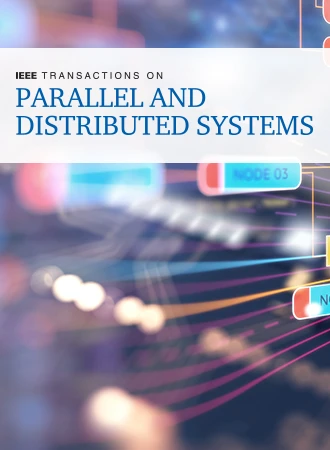FedTune-SGM: A Stackelberg-Driven Personalized Federated Learning Strategy for Edge Networks
IF 5.6
2区 计算机科学
Q1 COMPUTER SCIENCE, THEORY & METHODS
IEEE Transactions on Parallel and Distributed Systems
Pub Date : 2025-02-18
DOI:10.1109/TPDS.2025.3543368
引用次数: 0
Abstract
Federated Learning (FL) has emerged as a prominent solution for distributed learning environments, enabling collaborative model training without centralized data collection. However, FL faces significant challenges such as data heterogeneity and resource-constraint edge devices for model training and analysis, leading to accuracy degradation and bias in model performance. To address these critical issues, we propose a novel FL strategy named FedTune-SGM, designed to optimize model training in decentralized settings. In this strategy, a cloud-based model is initially trained and fine-tuned on the edge devices with additional layers tailored to the specific data characteristics. This fine-tuning process effectively mitigates the impact of data heterogeneity, enhancing the robustness and generalization capability of the model. FedTune-SGM employs a strategic weighting mechanism that ensures a balanced and equitable contribution from participating edge devices to prevent dominant influences from resource-rich devices and promote a fairer and more accurate aggregated model. Additionally, the proposed strategy integrates a Stackelberg Game model to foster an interactive and dynamic cloud-edge setup that motivates edge devices to invest more effort in model training and ensures the effectiveness of resource-constraint edge devices. Extensive experiments conducted on three diverse datasets highlight the superior performance of the proposed FedTune-SGM strategy compared to state-of-the-art FL techniques in terms of accuracy and robustness while meeting the critical challenges of data heterogeneity and resource limitations in FL environments. Through these innovations, FedTune-SGM paves the way for more reliable and efficient distributed learning systems, unlocking the full potential of FL in practical applications.FedTune-SGM:基于stackelberg驱动的边缘网络个性化联邦学习策略
联邦学习(FL)已经成为分布式学习环境的重要解决方案,它支持无需集中数据收集的协作模型训练。然而,在模型训练和分析中,FL面临着数据异构和资源约束边缘设备等重大挑战,导致模型性能精度下降和偏差。为了解决这些关键问题,我们提出了一种名为FedTune-SGM的新颖FL策略,旨在优化分散设置下的模型训练。在这种策略中,基于云的模型最初在边缘设备上进行训练和微调,并根据特定的数据特征定制额外的层。这种微调过程有效地减轻了数据异构的影响,增强了模型的鲁棒性和泛化能力。FedTune-SGM采用战略加权机制,确保参与的边缘设备做出平衡和公平的贡献,以防止资源丰富设备的主导影响,并促进更公平和更准确的汇总模型。此外,所提出的策略集成了Stackelberg博弈模型,以培养交互式和动态的云边缘设置,激励边缘设备在模型训练中投入更多精力,并确保资源约束边缘设备的有效性。在三个不同的数据集上进行的大量实验表明,与最先进的FL技术相比,所提出的FedTune-SGM策略在准确性和鲁棒性方面具有优越的性能,同时满足了FL环境中数据异构和资源限制的关键挑战。通过这些创新,FedTune-SGM为更可靠和高效的分布式学习系统铺平了道路,释放了FL在实际应用中的全部潜力。
本文章由计算机程序翻译,如有差异,请以英文原文为准。
求助全文
约1分钟内获得全文
求助全文
来源期刊

IEEE Transactions on Parallel and Distributed Systems
工程技术-工程:电子与电气
CiteScore
11.00
自引率
9.40%
发文量
281
审稿时长
5.6 months
期刊介绍:
IEEE Transactions on Parallel and Distributed Systems (TPDS) is published monthly. It publishes a range of papers, comments on previously published papers, and survey articles that deal with the parallel and distributed systems research areas of current importance to our readers. Particular areas of interest include, but are not limited to:
a) Parallel and distributed algorithms, focusing on topics such as: models of computation; numerical, combinatorial, and data-intensive parallel algorithms, scalability of algorithms and data structures for parallel and distributed systems, communication and synchronization protocols, network algorithms, scheduling, and load balancing.
b) Applications of parallel and distributed computing, including computational and data-enabled science and engineering, big data applications, parallel crowd sourcing, large-scale social network analysis, management of big data, cloud and grid computing, scientific and biomedical applications, mobile computing, and cyber-physical systems.
c) Parallel and distributed architectures, including architectures for instruction-level and thread-level parallelism; design, analysis, implementation, fault resilience and performance measurements of multiple-processor systems; multicore processors, heterogeneous many-core systems; petascale and exascale systems designs; novel big data architectures; special purpose architectures, including graphics processors, signal processors, network processors, media accelerators, and other special purpose processors and accelerators; impact of technology on architecture; network and interconnect architectures; parallel I/O and storage systems; architecture of the memory hierarchy; power-efficient and green computing architectures; dependable architectures; and performance modeling and evaluation.
d) Parallel and distributed software, including parallel and multicore programming languages and compilers, runtime systems, operating systems, Internet computing and web services, resource management including green computing, middleware for grids, clouds, and data centers, libraries, performance modeling and evaluation, parallel programming paradigms, and programming environments and tools.
 求助内容:
求助内容: 应助结果提醒方式:
应助结果提醒方式:


